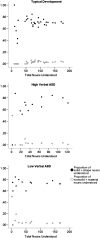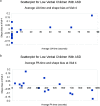The Shape Bias in Children With Autism Spectrum Disorder: Potential Sources of Individual Differences
- PMID: 30418496
- PMCID: PMC6693570
- DOI: 10.1044/2018_JSLHR-L-RSAUT-18-0027
The Shape Bias in Children With Autism Spectrum Disorder: Potential Sources of Individual Differences
Abstract
Purpose: Children with autism spectrum disorder (ASD) demonstrate many mechanisms of lexical acquisition that support language in typical development; however, 1 notable exception is the shape bias. The bases of these children's difficulties with the shape bias are not well understood, and the current study explored potential sources of individual differences from the perspectives of both attentional and conceptual accounts of the shape bias.
Method: Shape bias performance from the dataset of Potrzeba, Fein, and Naigles (2015) was analyzed, including 33 children with typical development (M = 20 months; SD = 1.6), 15 children with ASD with high verbal abilities (M = 33 months; SD = 4.6), and 14 children with ASD with low verbal abilities (M = 33 months; SD = 6.6). Lexical predictors (shape-side noun percentage from the MacArthur-Bates Communicative Development Inventory; Fenson et al., 2007) and social-pragmatic predictors (joint attention duration during play sessions) were considered as predictors of subsequent shape bias performance.
Results: For children in the low verbal ASD group, initiation of joint attention (positively) and passive attention (negatively) predicted subsequent shape bias performance, controlling for initial language and developmental level. Proportion of child's known nouns with shape-defined properties correlated negatively with shape bias performance in the high verbal ASD group but did not reach significance in regression models.
Conclusions: These findings suggest that no single account sufficiently explains the observed individual differences in shape bias performance in children with ASD. Nonetheless, these findings break new ground in highlighting the role of social communicative interactions as integral to understanding specific language outcomes (i.e., the shape bias) in children with ASD, especially those with low verbal abilities, and point to new hypotheses concerning the linguistic content of these interactions.
Presentation video: https://doi.org/10.23641/asha.7299581.
Figures


References
-
- Adamson L. B., Bakeman R., Suma K., & Robins D. L. (2017). An expanded view of joint attention: Skill, engagement, and language in typical development and autism. Child Development. Advance online publication. https://doi.org/10.1111/cdev.12973 - PMC - PubMed
-
- Akhtar N., Dunham F., & Dunham P. (1991). Directive interactions and early vocabulary development: The role of joint attentional focus. Journal of Child Language, 18, 41–49. - PubMed
-
- American Psychiatric Association. (2013). Statistical Manual of Mental Disorders–Fifth Edition (DSM-5). Washington, DC: Author.
Publication types
MeSH terms
Grants and funding
LinkOut - more resources
Full Text Sources
Medical

